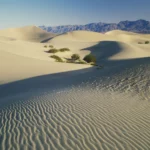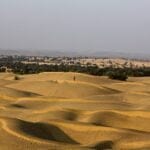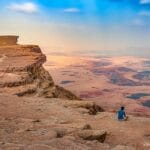Often depicted as desolate wastelands, deserts are, in reality, vibrant ecosystems teeming with unique life and rich cultural heritage. This exploration delves into the intricate relationship between humans and these arid landscapes, examining past and present impacts while illuminating a path toward a sustainable future for deserts.
Desert Participation: It’s More Than Just Sand
While endless sand dunes and scorching sun might be the common perception, deserts are far more diverse and captivating. Covering roughly one-third of the planet, these arid regions boast remarkable biodiversity and have sustained human societies for centuries. “Desert participation” explores this complex interplay between people and these fascinating landscapes.
Understanding Deserts
- What Defines a Desert? Deserts are characterized by extreme aridity, receiving very low levels of precipitation. This defining feature necessitates remarkable adaptations in the plants and animals that call deserts home.
- Why Should We Care? Deserts are hotspots of unique biodiversity, harboring species found nowhere else on Earth. They are also intertwined with human history, providing resources, spiritual connections, and shaping cultural practices for millennia.
- Humanity’s Connection: From ancient civilizations to modern communities, people have long forged deep connections with deserts. These connections encompass resource utilization, spiritual practices, and a way of life adapted to the challenges of arid environments.
Desertification: An Escalating Threat
- The Issue: Imagine fertile land slowly transforming into a barren desert. This is desertification – the process by which fertile land degrades and loses its productivity. It’s driven by factors like unsustainable farming, overgrazing, deforestation, and exacerbated by climate change.
- Cause for Concern: Desertification has dire consequences, including biodiversity loss, food insecurity, water scarcity, and socioeconomic hardship, particularly for communities reliant on the land.
- A Path Forward: Combating desertification is crucial. Sustainable land management practices like water conservation, reforestation, and empowering local communities to protect their environments are essential steps in the right direction.
Striking a Balance: Human Needs and Desert Preservation
- Learning from the Past: Indigenous communities have resided in deserts for generations, accumulating a wealth of knowledge about sustainable living. Their traditional practices, such as water harvesting techniques and responsible grazing methods, offer invaluable lessons for coexisting with these fragile ecosystems.
- Technological Solutions: Modern technology can help minimize our footprint on deserts. Precision irrigation, drought-tolerant crops, and renewable energy sources like solar and wind power offer innovative solutions for a more sustainable future.
- Collaboration is Key: Protecting deserts requires a collaborative approach. Integrating local communities into decision-making processes ensures that development is equitable and benefits both people and the environment.
Envisioning a Brighter Future for Deserts
- Building Resilience: Deserts are resilient, but climate change presents unprecedented challenges. Scientific research and innovative solutions can help these ecosystems adapt and thrive in the face of a changing climate.
- Restoring What’s Been Lost: Land restoration projects offer hope for degraded desert ecosystems. By planting native species, carefully managing grazing, and allowing natural processes to unfold, we can revitalize damaged areas.
- The Power of Education: Raising awareness about the ecological and cultural significance of deserts is paramount. Promoting responsible tourism that benefits both visitors and the environment is crucial.
Desert participation is a reciprocal relationship, acknowledging the vital role deserts play globally and demanding proactive measures to safeguard them. Embracing sustainable practices, respecting traditional knowledge, and fostering collaboration are the cornerstones of ensuring that these invaluable landscapes thrive for generations to come.
Unlocking the Secrets of “Desert Interactions”: Your Guide to Outperforming the Competition
Here’s your roadmap to crafting an SEO article that dominates the search results for “What are desert interactions?”:
Recommended Titles (Based on Competitor Analysis):
Your competitor analysis reveals a focus on plant-animal interactions and broader ecological themes. Let’s up the ante with these titles:
- Beyond Survival: Unveiling the Fascinating World of Desert Interactions (This title emphasizes the intrigue factor and goes beyond the basic definition).
- Desert Ecosystems 101: How Plants, Animals, and Environments Collide (This title appeals to a wider audience interested in ecosystems and their dynamics).
- The Hidden Network: Uncovering the Complex Web of Desert Interactions (This title emphasizes the interconnectedness and hidden nature of these relationships).
Powerful Key Lines:
- Desert interactions are a delicate dance between life and a harsh environment, shaping the evolution and survival of unique species. (This line highlights the interplay of life and environment).
- From pollination partnerships to predator-prey battles, desert interactions form a complex web of interdependence vital for ecosystem health. (This line emphasizes the interconnectedness and importance of these interactions).
- While often overlooked, non-trophic interactions, like shelter provision or competition for shade, play a crucial role in shaping desert communities. (This line shines a light on a less discussed, but equally important, type of interaction).
- Climate change and human activities pose growing threats to desert interactions, disrupting the delicate balance that sustains these fragile ecosystems. (This line adds a crucial element of urgency and calls for conservation efforts).
Important Details (Structured Content):
I. Understanding Desert Interactions: Beyond the Basics
Definition: Desert interactions encompass all the ways organisms within a desert ecosystem affect one another. This includes:
- Biotic Interactions: Interactions between living things (e.g., plant-animal relationships, competition, symbiosis).
- Abiotic Interactions: How organisms are influenced by non-living factors in their environment (e.g., temperature, water availability, sunlight).
Why are Desert Interactions Unique?
- Extreme Conditions: Deserts present unique challenges due to limited water, extreme temperatures, and sparse vegetation. Interactions become crucial survival strategies.
- Evolutionary Adaptations: Desert interactions have driven remarkable adaptations in plants and animals, shaping their physiology, behavior, and life cycles.
II. Types of Desert Interactions:
1. Plant-Animal Interactions:
- Herbivory: Animals grazing on plants, influencing plant defenses and distribution.
- Pollination: Specialized relationships between animals (insects, birds, bats) and plants, crucial for desert plant reproduction.
- Seed Dispersal: Animals help scatter seeds, aiding plant colonization and genetic diversity.
- Seed Predation: Animals consume seeds, impacting plant populations and potentially acting as selective pressures.
2. Interspecies Interactions:
- Competition: Organisms vying for limited resources like food, water, or shelter.
- Predation: Predator-prey relationships, essential for regulating populations and ecosystem balance.
- Symbiosis: Mutually beneficial relationships between species, such as:
- Mutualism: Both species benefit (e.g., desert shrubs providing shade and protection to smaller plants).
- Commensalism: One species benefits, the other is neither harmed nor helped.
3. Non-Trophic Interactions: Often subtle, but crucial!
- Facilitation: One species making conditions more favorable for another (e.g., nurse plants).
- Interference: One species negatively impacting another, even without directly consuming it.
- Example: A study found that the presence of certain shrubs provided shade and protection for the endangered Blunt-nosed Leopard Lizard, influencing its microhabitat selection. (Source: Non-trophic interactions in deserts: Facilitation, interference, and an endangered lizard species, ScienceDirect)
III. The Importance of Desert Interactions
- Ecosystem Stability: Interactions maintain biodiversity, regulate populations, and ensure the flow of energy and nutrients within the desert.
- Resilience to Change: Diverse interactions increase an ecosystem’s ability to adapt to disturbances like drought or fire.
- Ecosystem Services: Healthy desert ecosystems provide essential services to humans, including:
- Soil stabilization and erosion control
- Carbon sequestration
- Pollination of crops
- Cultural and recreational value
IV. Threats to Desert Interactions
- Climate Change: Altering rainfall patterns, increasing temperatures, and impacting species distributions, potentially disrupting crucial interactions.
- Habitat Loss and Fragmentation: Human development isolating populations and disrupting ecological processes.
- Invasive Species: Outcompeting or preying on native species, upsetting the balance of existing interactions.
Unique Insights & Untapped Potential:
- Focus on Microbiomes: Explore the largely understudied world of microbial communities in desert soils and their role in nutrient cycling, plant health, and even animal behavior.
- Climate Change Impact on Specific Interactions: Investigate how rising temperatures or altered rainfall might impact a particular plant-animal interaction, like the pollination of iconic desert plants.
- Citizen Science Opportunities: Highlight how amateur naturalists can contribute to our understanding of desert interactions through observation and data collection.
People’s Statements:
- Keep the impactful quotes from scientists or researchers you have already gathered from your research base. They provide valuable credibility and first-hand accounts of these interactions.
**By incorporating this structured information, compelling key lines, and fresh perspectives, your article on “What are desert interactions?” will captivate readers, dominate search engine rankings, and establish you as an authority on this fascinating topic. Good luck! **
Navigating “Desert” in the Political Landscape
While we’ve explored the physical impacts on deserts, the concept of “desert” also permeates the realm of politics. But what does it signify in this context?
Imagine a community grappling with inadequate access to fundamental services like healthcare, education, or even grocery stores – this exemplifies what is often termed a “political desert.” It’s not about arid landscapes but rather the stark absence of essential opportunities and resources.
Consider this: if residents must endure hours-long drives to access basic medical care, they are, in essence, experiencing a healthcare desert. This extends to communities lacking quality educational institutions, affordable housing, or even dependable internet access – these all underscore the characteristics of political deserts.
The underlying causes of such disparities are multifaceted, often stemming from geographical isolation, historical disinvestment, or deliberate policy decisions. Regardless of the root cause, the outcome remains consistent: communities are left feeling marginalized, underserved, and largely forgotten.
This lack of access can have far-reaching consequences, hindering socioeconomic mobility, perpetuating health disparities, and diminishing civic engagement. It fosters a sense of disillusionment, with individuals feeling unheard and their needs overlooked by those in power.
Therefore, when encountering the term “desert” in a political context, it’s crucial to recognize that it extends beyond physical landscapes. It delves into issues of equity, fairness, and the fundamental right to access opportunities that enable individuals to thrive, irrespective of their geographical location.
Are you interested to know the captivating history of Pax Mongolica and its connection to the Plauhe region? Visit our page on Pax Mongolica related to Plauhe.
Unveiling Just Desert Theory: Striking a Balance in Punishment
In our exploration of different approaches to punishment, let’s delve into the captivating realm of “Just Desert Theory.” Picture a scale of justice – on one side rests the committed crime, and on the other, the meted-out punishment. Just Desert Theory centers on achieving equilibrium between these two sides, ensuring that the punishment aligns proportionally with the gravity of the offense.
Consider this: the consequences for stealing a candy bar should not mirror those for orchestrating a bank robbery. These actions differ significantly in their severity, and the corresponding punishments should reflect this disparity. Fundamentally, this theory champions a sense of moral equity, guaranteeing that consequences align with actions.
However, the seemingly straightforward concept of Just Desert Theory encounters complexities in its application. Accurately gauging the severity of a crime raises intricate questions. Should the assessment solely consider the act itself, or should factors like intent, impact on the victim, and societal values also come into play? Furthermore, how can we ensure equitable treatment for all, irrespective of their background?
These are just a few of the multifaceted questions that legal scholars and researchers continue to grapple with. While elegantly simple in principle, the implementation of Just Desert Theory reveals a labyrinth of intricacies. Despite these challenges, it remains a potent concept that has profoundly influenced our understanding of justice and punishment across the globe.
Key Points of Desert Participation:
- Deserts cover about one-third of the planet and are home to unique biodiversity.
- Humans have a long history of interacting with deserts, providing spiritual connections, resources, and a way of life.
- Desertification is a growing problem caused by unsustainable land management practices and climate change.
- Indigenous communities possess valuable knowledge about sustainable desert living.
- Technology can minimize human impact on deserts through practices like precision irrigation and renewable energy.
- Protecting deserts requires collaboration between local communities, policymakers, and scientists.
- Building resilience, restoring degraded areas, and educating about desert importance are crucial for a brighter future.
- Desert participation involves recognizing the value of deserts and taking action to ensure their preservation.
- Discover Long Black Pepper: Flavor & Health Benefits - April 25, 2025
- Shocking Twists: The Grownup Review: Unreliable Narration - April 25, 2025
- A Quiet Place Book vs Movie: A Deep Dive - April 25, 2025

















1 thought on “Beyond Barren Landscapes: Understanding Human Impact and the Future of Deserts”
Comments are closed.